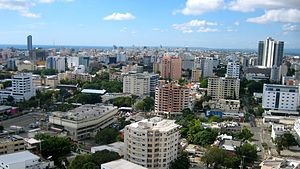[vc_row type=”standard_section” bg_image=”” bg_repeat=”stretch” parallax_bg=”” stellar_class=”default” bg_color=”” section_arrow=”” video_bg=”” enable_video_color_overlay=”” video_overlay_color=”” video_webm=”” video_mp4=”” video_ogv=”” video_image=”” text_color=”dark” custom_text_color=”” text_align=”left” top_padding=”10″ bottom_padding=”” class=”” row_id=””][vc_column animation=”none” bg_color=”” bg_image=”” column_padding=”no-padding” column_custompadding=”0px 0px 0px 0px” column_center=”” text_color=”dark” custom_text_color=”” text_align=”left” width=”1/1″][vc_column_text]
Santo Domingo, Dominican Republic
 Santo Domingo (Spanish pronunciation: [ˈsanto ðoˈmiŋɡo] meaning “Saint Dominic“), known officially as Santo Domingo de Guzmán, is the capital and largest city in the Dominican Republic and the largest city in the Caribbean by population. In 2010, its population was counted as 965,040, rising to 2,907,100 when its surrounding metropolitan area was included. The city lies within the boundaries of the Distrito Nacional (“D.N.”, “National District”), itself bordered on three sides by Santo Domingo Province.
Santo Domingo (Spanish pronunciation: [ˈsanto ðoˈmiŋɡo] meaning “Saint Dominic“), known officially as Santo Domingo de Guzmán, is the capital and largest city in the Dominican Republic and the largest city in the Caribbean by population. In 2010, its population was counted as 965,040, rising to 2,907,100 when its surrounding metropolitan area was included. The city lies within the boundaries of the Distrito Nacional (“D.N.”, “National District”), itself bordered on three sides by Santo Domingo Province.
Founded by Bartholomew Columbus in 1496, on the east bank of the Ozama River and then moved by Nicolás de Ovando in 1502 to the west bank of the river, the city is the oldest continuously inhabited European settlement in the Americas, and was the first seat of the Spanish colonial rule in the New World. Santo Domingo is the site of the first university, cathedral, castle, monastery, and fortress in the New World. The city’s Colonial Zone was declared as a World Heritage Site by UNESCO. Santo Domingo was called Ciudad Trujillo (Spanish pronunciation: [sjuˈðað tɾuˈhiʎo]), from 1936 to 1961, after the Dominican Republic’s dictator, Rafael Trujillo, named the capital after himself. Following his assassination, the city resumed its original designation.
Santo Domingo is the cultural, financial, political, commercial and industrial center of the Dominican Republic, with the country’s most important industries being located within the city. Santo Domingo also serves as the chief seaport of the country. The city’s harbor at the mouth of the Ozama River accommodates the largest vessels, and the port handles both heavy passenger and freight traffic. Temperatures are high year round, with a cool breeze around winter time.[/vc_column_text][/vc_column][/vc_row][vc_row type=”standard_section” bg_image=”” bg_repeat=”stretch” parallax_bg=”” stellar_class=”default” bg_color=”” section_arrow=”” video_bg=”” enable_video_color_overlay=”” video_overlay_color=”” video_webm=”” video_mp4=”” video_ogv=”” video_image=”” text_color=”dark” custom_text_color=”” text_align=”left” top_padding=”10″ bottom_padding=”25″ class=”” row_id=””][vc_column animation=”none” bg_color=”” bg_image=”” column_padding=”no-padding” column_custompadding=”0px 0px 0px 0px” column_center=”” text_color=”dark” custom_text_color=”” text_align=”left” width=”1/1″][vc_column_text]
[/vc_column_text][/vc_column][/vc_row][vc_row type=”standard_section” bg_image=”” bg_repeat=”stretch” parallax_bg=”” stellar_class=”default” bg_color=”” section_arrow=”” video_bg=”” enable_video_color_overlay=”” video_overlay_color=”” video_webm=”” video_mp4=”” video_ogv=”” video_image=”” text_color=”dark” custom_text_color=”” text_align=”left” top_padding=”” bottom_padding=”” class=”” row_id=””][vc_column animation=”none” bg_color=”” bg_image=”” column_padding=”no-padding” column_custompadding=”0px 0px 0px 0px” column_center=”” text_color=”dark” custom_text_color=”” text_align=”left” width=”1/1″][vc_column_text]
Travel Tips
Traveling can increase your chances of getting sick. A long flight can increase your risk for deep vein thrombosis. Once you arrive, it takes time to adjust to the water, food, and air in another place. Water in developing countries can contain viruses, bacteria, and parasites that cause stomach upset and diarrhea. Be safe by using only bottled or purified water for drinking, making ice cubes, and brushing your teeth. If you use tap water, boil it or use iodine tablets. Food poisoning can also be a risk. Eat only food that is fully cooked and served hot. Avoid unwashed or unpeeled raw fruits and vegetables.
If you are traveling out of the country, you might also need vaccinations or medicines to prevent specific illnesses. Which ones you need will depend on what part of the world you’re visiting, the time of year, your age, overall health status, and previous immunizations. See your doctor 4 to 6 weeks before your trip. Most vaccines take time to become effective.[/vc_column_text][/vc_column][/vc_row][vc_row type=”standard_section” bg_image=”” bg_repeat=”stretch” parallax_bg=”” stellar_class=”default” bg_color=”” section_arrow=”” video_bg=”” enable_video_color_overlay=”” video_overlay_color=”” video_webm=”” video_mp4=”” video_ogv=”” video_image=”” text_color=”dark” custom_text_color=”” text_align=”left” top_padding=”10″ bottom_padding=”20″ class=”” row_id=””][vc_column animation=”none” bg_color=”” bg_image=”” column_padding=”no-padding” column_custompadding=”0px 0px 0px 0px” column_center=”” text_color=”dark” custom_text_color=”” text_align=”left” width=”1/1″][vc_column_text]
[/vc_column_text][/vc_column][/vc_row]












